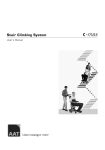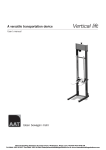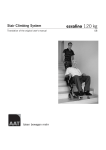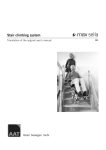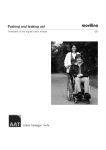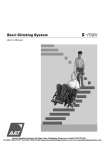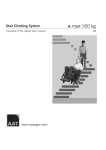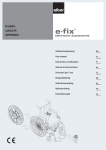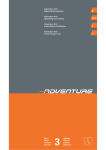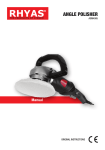Download C-max 140 kg
Transcript
Stair Climbing System Translation of the original user’s manual C-max 140 kg GB c-max 140 kg CE Declaration of conformity The company AAT Alber Antriebstechnik GmbH herewith declares that the products of the stair climbing system C-max were developed and manufactured in concordance with the current regulations of the European Union, EEC Guidelines 2007/47/EG and 2006/42/EG. This declaration becomes void if the above mentioned devices have been altered without the consent of AAT Alber Antriebstechnik GmbH. Signature of the manufacturer: Markus Alber Managing shareholder AAT Alber Antriebstechnik GmbH AAT Alber Antriebstechnik GmbH P.O. Box 10 05 60 · D-72426 Albstadt Tel.: +49 - 74 31 - 12 95 0 · Fax.: 12 95 35 [email protected] · www.aat-online.de 2 c-max_140kg_gb_05/2010 The stair climbing system C-max has been successfully tested and certified according to the standard design for stair climbing vehicles ISO 7176-23 and DIN EN 12182 at the Technical University of Berlin, Berlin-Cert. c-max 140 kg Table of contents CE Declaration of conformity . . . . . . . . . . . . Table of contents . . . . . . . . . . . . . . . . . 2 3 1 General information . . . . . . . . . . 1.1 How to use this user's manual 1.2 Instruction . . . . . . . . . 1.3 Care and maintenance . . . . 1.4 Warranty and liability. . . . . . . . . . . . . . . . . . . . . . . . . . . . . . . . . . . . . . . . . . . . . . . . . . . . . . . . . . . . 5 5 5 5 5 2 Description of the product . . . . . 2.1 Adequate use . . . . . . 2.2 Features of the C-max . . 2.3 Technical data . . . . . . 2.4 Dimensioned sketch . . . 2.5 Standard scope of delivery 2.6 Optional accessories . . . . . . . . . . . . . . . . . . . . . . . . . . . . . . . . . . . . . . . . . . . . . . . . . . . . . . . . . . . . . . . . . . . . . . . . . . . . . . . . 6 6 7 7 8 9 9 3 Assembly. . . . . . . . . . . . . . . . . . . . . . . . 3.1 Attach the back rest to the climbing frame. . . . 3.2 Affix the back rest . . . . . . . . . . . . . . . 3.3 Attach the C-part plus seat to the climbing frame 3.4 Affix the C-part . . . . . . . . . . . . . . . . 3.5 Helix cable . . . . . . . . . . . . . . . . . . 3.6 Attach the battery pack. . . . . . . . . . . . . 3.7 Detach the battery pack . . . . . . . . . . . . 3.8 Arm rests . . . . . . . . . . . . . . . . . . . 3.9 Handles . . . . . . . . . . . . . . . . . . . . 3.10 Functional check. . . . . . . . . . . . . . . . . . . . . . . . . . . . . . . . . . . . . . 10 10 10 10 10 11 11 11 12 12 12 4 Safety instructions . . . . . . . . . . . . 4.1 Special information concerning the 4.2 Instruction . . . . . . . . . . . 4.3 Safety brakes . . . . . . . . . . 4.4 Lining of the climbing foot . . . . 4.5 Lifting capacity . . . . . . . . . 4.6 Care and maintenance . . . . . . 4.7 Condition of paths, walkways etc. . 4.8 Charge of the batteries . . . . . . 4.9 Climbing mechanism . . . . . . . 4.10 Transport . . . . . . . . . . . . . . . . . operation . . . . . . . . . . . . . . . . . . . . . . . . . . . . . . . . . . . . . . . . . . . . . . . . . . . . . . . . . . . . . . . . . . . . . . . . . . . . . . . . . . . . . . . . . 13 13 14 14 14 14 14 14 15 15 15 5 Operation . . . . . . . . . . . . 5.1 Maximum lifting capacity . 5.2 Control light . . . . . . . 5.3 Helix cable connector . . 5.4 Battery pack . . . . . . . 5.5 Safety brakes . . . . . . 5.6 Lining of the climbing foot . . . . . . . . . . . . . . . . . . . . . . . . . . . . . . . . . . . 16 16 16 16 16 16 16 . . . . . . . . . . . . . . . . . . . . . . . . . . . . . . . . . . . . . . . . . . . . . . . . . . . . . . . . . . . . . . . . . . . . . . 3 c-max 140 kg 6 Instructions for operation . . . . . . . . . 6.1 Control unit . . . . . . . . . . . 6.2 Single step control . . . . . . . . 6.3 Climbers . . . . . . . . . . . . 6.4 Safety brakes . . . . . . . . . . 6.5 Transportation of a person with the 6.6 Operation on level ground . . . . 6.7 Adjust the handles . . . . . . . . 6.8 Tilting the stair climbing system . 6.9 Operation on slopes . . . . . . . 6.10 Climbing upstairs . . . . . . . . 6.11 Climbing downstairs . . . . . . . 6.12 Laying the C-max on the stairs . . 6.13 Transport . . . . . . . . . . . . 6.14 Trouble shooting . . . . . . . . . . . . . . . . . . . . . . . . C-max . . . . . . . . . . . . . . . . . . . . . . . . . . . . . . . . . . . . . . . . . . 17 17 18 19 19 20 21 21 22 22 23 26 28 29 29 7 Accessories. . . . . . . . . . . . . . . . . . . . . . . . . 7.1 Battery pack . . . . . . . . . . . . . . . . . . . . 7.2 Charging cable for your vehicle . . . . . . . . . . . 30 30 30 8 Care, maintenance and recycling. . . . . . . 8.1 New user . . . . . . . . . . . . . 8.2 Charger . . . . . . . . . . . . . . 8.3 Battery pack . . . . . . . . . . . . 8.4 Fuses . . . . . . . . . . . . . . . 8.5 Check brake lining . . . . . . . . . 8.6 Check the lining of the climbing foot 8.7 Cleaning . . . . . . . . . . . . . 8.8 Recycling . . . . . . . . . . . . . . . . . . . . . . 31 31 31 32 34 35 35 36 36 9 Warranty and liability . . . . . . . . . . . . . . . . . . . . 9.1 Warranty . . . . . . . . . . . . . . . . . . . . . 9.2 Liability . . . . . . . . . . . . . . . . . . . . . . 37 37 37 . . . . . . . . . . . . . . . . . . . . . . . . . . . . . . . . . . . . . . . . . . . . . . . . . . . . . . . . . . . . . . . . . . 4 . . . . . . . . . . . . . . . . . . . . . . . . . . . . . . . . . . . . . . . . . . . . . . . . . . . . . . . . . . . . . . . . . . . . . . . . c-max 140 kg 1 General information Congratulations! With the acquisition of this stair climbing system you have a device that will quickly become a reliable and indispensable partner in transporting physically disabled people. With the C-max you are able to transport one person safely and effortlessly up- and downstairs; even winding stairs are no problem for the C-max. Driving on slopes is also possible. The safety brakes on both sides of the C-max ensure your safety. Naturally the C-max is also suitable to drive on level ground. The device is lightweight, flexible and does not take up much space. The c-max is capable of climbing stairs up to a step heigth of 21 cm. The minimum depth of the step’s surface must be 14 cm, regardless of the type of stairs (regular straight stairs or winding stairs). The necessary step width concerning straight stairs is the width of the c-max plus an extra 10 cm for manoeuvring. The minimum platform size for u-shaped stairs depends on factors such as the attendant's height, etc. Your AAT representative or your authorized dealer are happy to advise you. The sticker with the device's serial number is located on the left side of the housing. Read the number here. 1.1 How to use this user's manual The user’s manual is part of the delivery package and instruct you step by step about the safe and adequate use of the c-max. Operating the c-max takes a certain skill. Please read this user’s manual carefully and particularly take note of the safety instructions before you use the c-max for the first time. After reading, please store this user’s manual at an appropriate place for further reference. 1.2 Instruction In the interest of your safety the c-max may only be operated by trained personnel. Instruction on how to operate the device is part of the delivery package and takes place with your authorized dealer or an AAT representative. F 1.3 Please read this user’s manual carefully and particularly take note of the safety instructions before you use the C-max for the first time. Care and maintenance One of the most important aspects concerning the maintenance of the C-max is charging the sealed lead acid batteries. They are part of the battery pack and must be charged every time after using the device. Other than that your C-max does not need much care or maintenance. More extensive instructions you find in chapter 8. 1.4 Warranty and liability For damage that was caused by inadequate use disregarding this manual we assume no liability whatsoever. (Please read chapter 9 for more detailed information concerning warranty and liability). 5 c-max 140 kg 2 Description of the product 2.1 Adequate use Please use the C-max exclusively for the transportation of physically disabled persons. Said persons should be able to sit properly without help, otherwise you should secure them with a safety belt. The latter is an accessory available at AAT Alber Antriebstechnik GmbH. In addition, the arms of the person to be transported should not protrude over the arm rests during the transportation process. F F F F F In the interest of your safety you may not use the stair climbing device C-max on escalators or moving belts! Transporting other kinds of loads is explicitly prohibited! Only authorized operators may use the c-max. Therefore never leave the c-max unattended. Please do not use the c-max in rain, slippery and wet conditions, Driving on level ground snow or ice due to the following potential safety hazards, e.g. danger of slipping restricted braking effect etc. Due to safety reasons the c-max may only be operated by trained personnel who are physically and intellectually capable to handle the device in all situations of operation. Mastering stairs Driving on slopes 6 c-max 140 kg 2.2 Features of the C-max 1 = control unit 2 = handles, adjustable 3 = back rest 4 = arm rest, swivels out 5 = C-part plus seat 6 = climbing frame 7 = foot rest, folds in 8 = main wheel 9 = lever with chain drive 10 = climber and climbing foot 11 = safety brake 12 = climbing unit 13 = battery pack 14 = tightening knobs for the back rest 15 = single step switch 16 = tightening knob for the handle 2.3 Technical data measurements height = 1090 mm width without arm rests = 440 mm width with arm rests attached = 485 mm depth with the foot rest folded in = 730 mm depth with the foot rest folded out = 915 mm weight climbing frame = 17,2 kg, C part plus seat = 4,6 kg, back rest = 4,3 kg, both arm rests = 1,2 kg, battery pack = 4,4 kg, total weight = 31,7 kg maximum lifting capacity 140 kg batteries 2 x 12 V / 5 Ah sealed lead acid direct current motor 24 V / 275 W climbing speed 8 - 23 steps / minute, continually adjustable capacity with one battery charge 15 - 30 floors, depending on the load maximum height of step 21 cm noise level the device’s A weighted noise level lies typically below 70 dB (A) storing/operating temperature,device 0° C up to + 60° C / - 30° C up to + 50° C storing/operating temperature,batteries 0° C up to + 60° C / - 30° C up to + 50° C vibrations the weighted RMS value of acceleration the upper body is exposed to lies typically below 2.5 m/s² 7 c-max 140 kg Dimensioned sketch ° .0 215 350 Sitztiefe: 410 / Sitzbreite: 4 60 5° 225 430 ° 80 390 730 915 8 Rückenhöhe:1080 / Gesamtbreite:485 15 500 2.4 c-max 140 kg 2.5 Standard scope of delivery 1 = charger including instructions 2 = battery pack 1 3 = arm rests 4 = back rest 5 = C-part 6 = climbing unit plus the user's manual 2 2.6 3 4 5 6 Optional accessories 1 = head rest 2 = charging cable for the car 3 = widened arm rests 4 = seat belt system including hip belt 5 = hip belt 6 = children’s foot rest 7 = extended / shortened foot rest 8 = increase of climbing height 9 = inclination indicator 10 = extended handles (not illustrated) 1 2 3 4 5 9 6 7 8 9 c-max 140 kg 3 Assembly With a few movements you can assemble the C-max by means of several fixtures and tightening knobs. Disassembly is just as easy. 3.1 Attach the back rest to the climbing frame Put the back rest onto the guide pins on top of the climbing frame. 3.2 Affix the back rest Fix the back rest tightly to the climbing frame with the two tightening knobs. F 3.3 Always make sure that the back rest is securely fastened to the climbing frame. Attach the C-part plus seat to the climbing frame Put the C-part plus seat onto the climbing frame; the locating bolts of the C-part fit into the corresponding holes in the frame. 3.4 Affix the C-part Fix the C-part tightly to the climbing frame with the two tightening knobs. F Always make sure that the C-part plus seat is securely fastened to the climbing frame. 10 c-max 140 kg 3.5 Helix cable Put the connector of the helix cable into its socket located on the climbing unit's housing. Lock the connector by pushing up the latching. F 3.6 Be catious that neither connector nor socket become wet by e.g. water or snow - this may cause a short circuit between pins and result in severe malfunction of the system. Attach the battery pack Push the battery pack into its fixture by means of the guiding pins on top of the climbing unit's housing. This establishes the power connection and locks the battery pack. 3.7 Detach the battery pack Unlock the battery pack by pressing the release button on top of the battery pack until it engages.Then lift out the battery pack. 11 c-max 140 kg 3.8 Arm rests Insert arm rests on both sides. F 3.9 Please always make sure that the stop bolts snap in their appropriate notches. Handles Adjust handles to the appropriate height on both sides (see chapter 6.7) then fasten them with the tightening knobs . F 3.10 F F F F F After adjusting the handles, always make sure that they are securely fastened. Functional check Please check the safety brakes each time before using the device (see chapter 6.4 and 8.5)! Please also check the safety brakes’ braking effect as described in chapter 6.4.1 and 6.4.2! Please check the device’s electronic functions each time before using it (see chapter 6.10 and 6.11)! Regularly check whether the climbing feet’s linings are still sufficient (see chapter 8.6) Make sure that the battery pack is charged before you use the device! 12 c-max 140 kg 4 F Safety instructions For a safe operation of the c-max it is important that you observe and adhere to all warning signs and instructions in this user’s manual as well as the warning signs and instructions on the device itself. 4.1 Special information concerning the operation: Due to safety reasons the stair climber c-max may not be used on escalators and moving walkways! 4.1.1 Environmental conditions, electro-magnetic compatibility: Electro-magnetic compatibility means that an electric device functions properly in its electro-magnetic environment without influencing other devices in the same environment. Warning: Radio wave sources may affect powered device control! Radio wave source, such as radio stations, TV stations, amateur radio (HAM) transmitters, two-way radios, and cellular phones, can affect your c-max. Following the warning listed below should reduce the chance of unintended brake release or movement, which could result in serious injury. F F F F F Do not turn ON hand-held personal communication devices, such as citizens band (CB) radios and cellular phones, while the c-max is turned ON. Be aware of nearby transmitter, such as radio or TV stations, and try to avoid coming close to them. If unintended movement or brake release occurs, turn the powered c-max OFF as soon as it is safe. Be aware that adding accessories or components, or modifying the c-max, may take it more susceptible to interference from radio wave sources (Note: There is no easy way to evaluate their effect on the overall immunity to the c-max). Report all incidents of unintended movement or brake release to the c-max manufacturer, and note whether there is a radio wave source nearby. Important EMI-Information: F F F F 20 Volts per meter (V/m) is a generally achievable and useful immunity level against interference from radio wave sources (as of May 1994) (the higher the level, the greater the protection). This device has an immunity level of 20 V/m with no accessories connected to the device. Nevertheless, always check whether the device’s electronic functions work properly before each use. This is particularly important if there is an aerial mast nearby. Please note that the c-max may interfere with other electronic devices’ sensitive electro-magnetic fields (e.g. anti-theft systems in department stores). This may also happen if you connect other devices. 13 c-max 140 kg F Also make sure that the c-max is not operated in close proximity to medical devices with a high potential for danger and/or life-supporting functions as well as diagnostic devices. 4.1.2 Climate: To ensure proper functioning it is not advisable to expose the c-max to freezing conditions. Should this be unavoidable, always put the device in a non-freezing environment for at least one hour before using it. 4.2 Instruction: The C-max may only be operated by trained personnel. In addition, the operator should be capable of lifting 1/3 of his or her own weight. Minors are not allowed to use the C-max; exempt from the above are adolescents over 16 years of age who have been trained under supervision to operate the C-max. While using the C-max you should always wear good shoes that do not slip. 4.3 Safety brakes: Please check the safety brakes each time before using the C-max (see also chapter 6.4 and 8.5). The safety brakes, particularly the knurled surface of the brake drums in the wheel rims, must be cleaned weekly or after contamination with spirit to ensure the optimum braking effect. F F F Never smoke during the cleaning of the device as well as keep it away from ignition source. Please consider the danger warning of the manufacturer previous cleaning the device with spirit. Never use suds or greasy cleaners. After cleaning the safety brakes must be checked as described in chapter 6.4 4.4 Lining of the climbing foot: Please check regularly whether the lining of each climbing foot is still sufficient (see chapter 8.6). 4.5 Lifting capacity: The stated maximum lifting capacity of 140 kg may not be exceeded. Please also read chapter 5.1. You may under no circumstances use the C-max to transport goods. 4.6 Care and maintenance: Please make sure that you charge the battery pack after each use of the C-max. If the c-max is not in operation, please turn off the device. If the working elements of the device block, turn the C-max off immediately. F Repairs may be done by authorized dealers or the manufacturer only. Please exclusively use AAT Alber parts and accessories. Please note the extensive care and maintenance instructions in chapter 8. 4.7 Condition of paths, walkways etc.: Please make sure that the paths and walkways you use with the C-max are free of obstacles and not slippery. Avoid operation on damaged stair linings, snow, ice, etc. F The C-max may not be used in wet and rainy conditions. 4.7.1. Environmental conditions: Although the c-max has been tested for its electro-magnetic compatibility, you should still check its electronic functions before each use. This is particularly important if there is an aerial mast nearby. 14 c-max 140 kg 4.8 Charge of the batteries: You should only use the C-max with fully charged batteries. In case the batteries run low on the stairs (a sequence of 2 flashes repeated every 2.5 seconds) the available charge of the batteries is sufficient to transport the person safely to the bottom of the stairs. Driving downstairs the motor works as a generator, thus recharging the batteries. The potential steps downward, therfore, are not limited. 4.9 Climbing mechanism: Please make sure that during the climbing process your hands and feet are in no way close to the rotating area. Always keep a safe distance. 4.10 F F F Transport: Make sure you never lift the device at the frame (see chapter 6.13). Always turn off the c-max for transportation! When you transport the device in vehicles, please secure it according to the relevant legal regulations in your country. 15 c-max 140 kg 5 Operation 5.1 Maximum lifting capacity Please make sure that the maximum lifting capacity of 140 kg is not exceeded. 5.2 Control light After turning on the device, the control light should light up and stay on. Flashing of the control light indicates malfunction. Further information on malfunction you find in chapter 6.1.6 5.3 Helix cable connector Check whether the connector of the helix cable is plugged into the housing of the climbing unit and locked each time before you use the C-max. 5.4 Battery pack Please make sure that the sealed lead acid batteries are fully charged before you use the C-max for the first time. Extensive instructions you find in chapter 8.3. 5.5 Safety brakes Before operating the C-max check the safety brakes every single time. Extensive instructions you find in chapter 6.4. 5.6 Lining of the climbing foot Please check regularly whether the lining on each climbing foot is still sufficient. Further instructions you find in chapter 8.6. 16 c-max 140 kg 6 Instructions for operation Before we get to the actual instructions for operation, we would like to introduce the C-max’s most important components to you: 6.1 Control unit The control unit is situated on the right handle and consists of an UP/DOWN switch , a speed control , a safety chip for the engine immobiliser and an ON/OFF switch . F 6.1.1 It is possible to supply you with a left-handed control for additional charge. ON/OFF switch If the C-max is not in operation, please turn the device off. F F 6.1.2 The C-max is equipped with a turn-off feature: if the device is on and has not been used for 5 minutes, the turn off feature switches the c-max off automatically. In such case you can only use the c-max again by pressing the ON/OFF switch. Should you have opted for the inclination indicator, it will also be automatically activated when you turn on your c-max. Inclination indicator (optional) If you wish the c-max can be equipped with an inclination sensor. Should you hold the device at an angle that is too high or too low, you will feel a vibration in the handle. The vibration increases the more you diverge from the ideal angle. If the handle does not vibrate you are within the ideal inclination angle to operate the c-max with ease. If your c-max has been equipped with this feature at your choice, it will vibrate for a few seconds every time you turn on the device. This is to tell you that the inclination indicator is active. Should this initial vibration not occur, please contact your authorized dealer or AAT Alber Antriebstechnik GmbH. 6.1.3 UP/DOWN switch With the UP/DOWN switch you activate the climbing mechanism up- or downstairs. 6.1.4 Speed control The speed control enables you to adjust the speed continuously. When you use the C-max for the first time, please choose the lowest speed. 6.1.5 Safety Chip for the engine immobiliser The UP/DOWN switch only works if you put the safety chip for the engine immobiliser into its slot. Please make sure that the chip is properly set to ensure safe and continuous operation. If you do not put in the chip you can turn on the c-max, but you cannot drive with it. This feature makes sure that no unauthorized person uses the device. 17 c-max 140 kg 6.1.6 Control light to indicate malfunction After turning on the C-max the green control light (LED) lights up and remains lit, which indicates that the stair climbing system is in order and ready to use. Potential malfunction is indicated by a light diode. After a period of 3 seconds each time a blinking signal is repeated. In case of malfunction, turn the device first off and then on again. If there is still an indication of malfunction, charge the batteries in case of low battery charge. For all other cases of malfunction, please contact your authorized dealer. LED is blinking Identified malfunction 1 overload of the device 2 battery pack, undervoltage 3 overvoltage 4 UP/DOWN switch or its supply line is damaged 5 defective electromagnetic brake 6 malfunction of electronics 6.2 Single step control The single step switch is located on the climbing frame (see pictures). Please activate the single step mode to practise and in particular to climb winding stairs. If you activate the ON/OFF switch in that mode, the device will climb only one step at a time. The climbing system stops in the correct position, even if you press the ON/OFF switch continuously. The climbing mechanism cannot unintentionally be activated. You can take your time to move the main wheels to the next step’s edge. F To continue climbing you simply release the UP/DOWN switch and then press it again. 18 I The arrows with the dotted line symbolize the interruption of the climbing process, i.e. the single step mode is activated. To do that you press the rocker switch on I. By contrast, if you press the rocker switch on O it signifies the uninterrupted climbing process, i.e. the single step mode is OFF. c-max 140 kg 6.3 Climbers The climbers (see picture) must be pulled in to topmost position by means of the UP/DOWN switch if you want to: • drive on level ground and on slopes • check the safety brakes • begin climbing upstairs or downstairs However, you need to fold out the climbers by activating the UP/DOWN switch, direction up, whenever a person takes a seat in the c-max, so the device is supported by the climbers (please also see chapter 6.5.1). 6.4 Safety brakes There are safety brakes located on the climbing frame on both sides. F Please check the safety brakes each time before you use the C-max. You may check the brake effect either on top of the stairs or on level ground as described in 6.4.1 and 6.4.2. 6.4.1 Test the required brake effect Pull in the climbers to their upmost position and tilt the C-max backwards until the back rest is in an almost horizontal position (see picture). If the C-max cannot be pushed forward by the handles in said position, but merely rolls backwards, then the required brake effect for the safe operation of the C-max is granted (see picture). F F Important: If the required brake effect is not guaranteed, you may, under no circumstances, use the C-max any more. Please contact your authorized AAT Alber dealer or the manufacturer immediately. Should the brake not kick in, you may under no circumstances use the device. Please contact your authorized dealer or an AAT representative immediately. 6.4.2 Test the required brake effect at the top edge of the stairs F Please make this test without a person sitting in the chair. Pull in the climbers to their upmost position and tilt the device backwards until the back rest is in an almost horizontal position. Drive forward to the first step’s edge (without person). If you cannot push the device over the edge of the step, the required braking effect for a safe operation of the C-max is granted. F F Important: If the required brake effect is not guaranteed, you may, under no circumstances, use the C-max any more. Please contact your authorized AAT Alber dealer or the manufacturer immediately. Should the brake not kick in, you may under no circumstances use the device. Please contact your authorized dealer or an AAT representative immediately. 19 c-max 140 kg 6.5 Transportation of a person with the C-max Please note that the C-max was developed to be operated by one person. Always use both hands when using the device. F F Only one person may be transported with the c-max. Please practice driving with the C-max on level ground, slopes and climbing up- and downstairs at first without a person sitting in the chair! Also make sure that while you practise using the c-max nobody is within close range of the potentially dangerous area underneath the device. We suggest that you practice climbing up- and downstairs with the single step mode activated (see chapter 6.2). Also choose the lowest climbing speed for practicing (see chapter 6.1.4) F F Please do not exceed the maximum lifting capacity (see chapter 5.1) In the interest of your safety please always operate the c-max from behind, never sideways. When a person takes a seat on the c-max, please follow these instructions: 6.5.1 Secure stand of the C-max To avoid the c-max moving when a person takes a seat, you must fold out the climbers in such a way that they rest on the ground. Turn on the device and press the UP/DOWN switch direction UP until the climbers touch the floor. 6.5.2 Swivel out or remove the arm rests Sitting down can be facilitated by folding out the arm rests. If necessary you can remove the arm rests altogether. After the person to be transported has taken a seat you put the arm rests back into their original position. 6.5.3 Fold out the foot rest When a person is transported, please fold out the foot rest (see picture), and, if necessary, help the person to place his/her feet on it. 20 c-max 140 kg 6.6 Operation on level ground After the person has been properly seated, you may transport him or her effortlessly on level ground (see picture). Make sure that the climbers are pulled in entirely. F 6.7 You overcome a threshold by pulling the C-max backwards over it. Adjust the handles For climbing stairs or driving on slopes, comfortably and safely, adjust the height of the handles approximately to the level of the operator's shoulders. Release the tightening knob counter clockwise and adjust the handle as desired. F After adjusting the handles, always make sure that they are securely fastened. 21 c-max 140 kg 6.8 Tilting the stair climbing system To drive on slopes or to climb stairs you must tilt the C-max, which can be done easily by means of the climbers. 1. Turn on the C-max by pressing the ON/OFF switch. 2. Press the UP/DOWN switch direction DOWN until the climbers lift the main wheels at least 1-2 cm off the floor (see picture). 3. Put your foot on the housing and tilt the C-max slightly toward you until you feel that the C-max is balanced. 4. The C-max is balanced if you feel neither pull nor push in the handles. 5. In order to drive on level ground, the climbers must be pulled in entirely If you tilt the C-max further, or too much, the safety brakes engage and the C-max can't be moved forward any more. 6.9 Operation on slopes To drive on a slope, make sure the handles are adjusted appropriately (see chapter 6.7). Now tilt the C-max slightly backwards and pull in the climbers entirely (see chapter 6.8). F 6.9.1 For safety reasons we recommend you to ask another person to assist when driving on a slope. Downhill Drive forward to the edge of the slope. In order to slow down you need to tilt the C-max a bit more, so that the safety brakes are activated. 6.9.2 Uphill Please drive backwards up a slope. In order to slow down you need to tilt the C-max a bit more, so that the safety brakes are activated. 22 c-max 140 kg 6.10 F F F Climbing upstairs You may only be permitted to transport a person with the c-max, if you have been properly trained in the device’s operation. Please always practice climbing stairs without a person and by activating the single step mode plus the lowest climbing speed. Please always check the safety brakes before each use (see chapter 6.4) The climbing process can be accomplished quickly and without problems if you adhere closely to the following instructions. A tip before you start: F Always pull the c-max a bit backwards during the entire climbing process, i.e. always keep the device under tension so that the wheels can touch down properly on the next step. 1. Adjust the handles to the appropriate height (see chapter 6.7) 2. Turn the C-max on by pressing the ON/OFF switch. 3. Activate the single step mode if necessary (see chapter 6.2) 4. Pull in the climbers to their topmost position by pressing the UP/DOWN switch (see chapter 6.3). 5. Tilt the C-max slightly toward you (see chapter 6.8). 6. Drive backwards to the stairs and move up 2 to 3 steps Now the C-max is in its initial position for climbing upstairs. F Make sure that both main wheels touch the lowest step 23 c-max 140 kg The climbing process takes place in two intervals. 7. F Press the UP/DOWN switch, direction UP to begin the climbing process by moving the climbers downward . Always keep the device under tension during the entire climbing process, i.e. always pull it slightly backward toward you. After the climbers reach the floor, they assume the load of the main wheels while the main wheels and the frame are lifted at the same time. 24 c-max 140 kg The first interval is finished when the main wheels touch down on the next higher step and resume the load of the climbers. The second interval begins by pulling in the climbers . It is finished when the climbers reach their topmost position. Because the C-max is always pulled slightly backward, it rolls automatically to the next step and reaches the initial position again - both main wheels touch the next step. If you activated the single step mode, the climbing process ends at this point. To resume climbing you need to press the UP/DOWN switch once again, direction UP. At this point the climbing process repeats itself as described in point 7. 25 c-max 140 kg 6.11 F F F Climbing downstairs You may only be permitted to transport a person with the c-max, if you have been properly trained in the device’s operation. Please always practice climbing stairs without a person, and by activating the single step mode plus the lowest climbing speed. Please always check the safety brakes before each use (see chapter 6.4). The climbing process can be accomplished quickly and without problems if you adhere closely to the following instructions. 1. Adjust the handles to the appropriate height (see chapter 6.7) 2. Turn the C-max on by pressing the ON/OFF switch. 3. Activate the single step mode if necessary (see chapter 6.2). 4. Pull in the climbers to their topmost position by pressing the UP/DOWN switch (see chapter 6.3). 5. Tilt the C-max slightly toward you (see chapter 6.8). 6. Drive the C-max forward to the edge of the stairs . The sensitive rolls of the safety brakes keep the C-max from rolling over the edge. 26 c-max 140 kg 7. Press the UP/DOWN switch, direction DOWN, and the descending process begins. The drive retracts the climbers downward and touch down on the next lower step. When the climbers reach the next lower step , they resume the load of the main wheels, while those plus the climbing frame are lifted off the higher step and then moves downward, away from the operator. 27 c-max 140 kg Now the main wheels and the climbing frame are moved forward - away from the operator. Afterwards the main wheels and the frame are lowered by retracting the climbers . This results in a small shift in load distribution, which you will feel at the handle by a slight pull forward. The main wheels rest now on the next step (see picture) and resume the load from the climbers, which are retracted further. If you activated the single step mode, the climbers are pulled in entirely and then the descending process ends at this point. 8. Again push the C-max all the way to the edge of the step, i.e. until the sensitive rolls of the safety brakes stop the C-max. To continue descending you need to press the UP/DOWN switch again, direction DOWN, if you activated the single step mode. At this point the climbing process repeats itself as described in point 7. 6.12 Laying the C-max on the stairs In an emergency the C-max may tilt backwards and lay down on the stairs. The safety brakes prevent the C-max from rolling down (see picture). 28 c-max 140 kg 6.13 Transport For transportation you may remove the c-max’s seat (see chapter 3). Should you choose to transport the c-max with the seat in place, then you best lift it holding on to the handle as well as the seat. F F F F F 6.14 Never lift the c-max on the base of the frame! Note that the device weighs 17.2 kg! Always turn off the c-max for transportation! When transporting the c-max in a vehicle, always secure the device according to the legal rules and regulations. The sealed lead acid batteries used in the c-max are not considered dangerous according to the IATA special guidelines A67 and GGVS Rn-Nr. 2801 A, section 2, and admitted to air travel by DOT and IATA. Trouble shooting If there are problems using the c-max, please check the following trouble shooting chart and see whether you can fix them yourself. problem check and potential solution Is the battery pack empty? If so, charge the batteries. c-max cannot be turned on Are the fuses damaged? If so, exchange the fuses. If there is still a problem turning on the c-max, please contact your dealer. c-max do not drive Is the safety chip for the engine immobiliser inserted? If so, please contact your dealer Batteries don't charge Please contact your dealer Potential malfunction is indicated by a light diode (see chapter 6.1.6). 29 c-max 140 kg 7 Accessories 7.1 Battery pack The c-max works with batteries and is delivered with one battery pack with charging electronics and safety latch. If you use the c-max often, i.e. if there are not sufficient breaks for the batteries to be recharged, we recommend you obtain an additional battery pack (available as an accessory). In such case one battery pack is in use while the other is being recharged at the same time. F F 7.1.1 If you do not use the c-max both battery packs should be connected to the charger to increase their durability (see chapter 8.3). Please exclusively use the AAT Alber Antriebstechnik GmbH charger to charge your battery pack. Exchange battery pack 1. Turn off the c-max using the ON/OFF switch. 2. Press the release button on top of the battery pack until it disengages. Now you pull out the battery pack at its handle from its fixture on the top of the climbing unit's housing . 3. Push the other fully charged battery pack from the top into its fixture by means of the guiding pins on top of the climbing unit's housing. This establishes the power connection and locks the battery pack. F F 7.2 The battery pack should always be connected to the charger to extend its durability (see chapter 8.3.2). Please exclusively use the AAT Alber Antriebstechnik GmbH charger to charge your battery pack. Charging cable for your vehicle A charging cable for your vehicle is recommended, if you transport the C-max frequently in your car. The charging cable is available as an accessory. The charging cable's plug fits into the socket of the car's cigarette lighter; connect the other plug to the battery pack. 30 c-max 140 kg 8 Care, maintenance and recycling To insure the C-max safe and proper functioning we recommend a safety check done on the device every two years, even though there might not be any outer damage or malfunction evident. F In the interest of your safety repairs of any kind may only be done by personnel authorized by AAT Alber Antriebstechnik GmbH. The device itself (as opposed to the batteries) does not need any particular maintenance except for an occasional cleaning (see chapter 8.7). 8.1 New user If the device goes to a new user, we recommend a safety check. 8.2 Charger Please exclusively use the AAT Alber Antriebstechnik GmbH charger to charge your battery packs. 8.2.1 Automatic charger The charger does not need any particular maintenance. The scope of delivery includes the AAT Alber Antriebstechnik GmbH charger. Plug is inserted into the wall outlet and plug into the socket on the device or the battery pack. This automatic charger recharges your batteries 100%. As soon as the charging process is completed, it switches to a retaining mode, thus overcharging is impossible. F F F F F F F Before using the charger, please read and follow all instructions and warning notes included with the charger. Exclusively use the AAT charger to charge the batteries. Check the charger regularly and protect it from oils, grease, aggressive cleaning agents, thinners and/or damage by sharp edges, etc. Repairs and service check-ups may only be performed by AAT Alber Antriebstechnik GmbH or their authorized personnel. Please do not disassemble or modify the charger! Please make sure that the charger is not exposed to dampness or humidity while charging the batteries. Never touch the plug with moist hands! 31 c-max 140 kg 8.2.2 Charging cable A charging cable for your vehicle is available as an accessory. Approximately a recharge of 80% is possible by accessing your vehicle’s battery using a charging cable. Connector fits to the cigarette lighter; plug in connector at the battery pack. F F F F 8.3 Before using the charging cable, please read and follow all instructions and warning notes included with the charging cable. Exclusively use the AAT Alber Antriebstechnik GmbH charging cable! Check the charging cable regularly and protect it from oil, grease, aggressive cleaning agents, thinners and/or damage by sharp edges, etc. Repairs and service check-ups may only be performed by AAT Alber Antriebstechnik GmbH or their authorized personnel. Battery pack The quick release battery pack, consisting of sealed lead acid batteries, should be recharged after each use. (Technical details for the sealed lead acid batteries you find in chapter 8.3.1). The battery pack is subject to a so-called self-discharge. Therefore, you should connect the battery pack to the charger whenever possible. Due to the fact that the battery pack automatically goes into charge retention as soon as it is fully charged, an overcharge is impossible. If your battery pack does not possess its full capacity yet, the reason may be that a new battery pack reaches its full capacity only after several charging/discharging cycles. If fully charged batteries discharge more quickly as before, they are probably used up. In such case, please have your authorized dealer check and replace them, if necessary. Tip: F If the C-max is at a standstill for some time, please connect it to the charger to retain the charge. This does not damage the sealed lead acid batteries, on the contrary, it increases their durability. 32 c-max 140 kg 8.3.1 Sealed lead acid batteries There are 2 sealed lead acid batteries 12 V / 5Ah in the battery pack of the C-max. These batteries are sealed, maintenance free, rechargeable and of top quality. The batteries of your C-max can be discharged or recharged in any possible position. They are considered as safe as dry cells and admitted for air travel according to DOT and IATA. Please avoid a total discharge: The durability of sealed lead acid batteries depends primarily on the charge/discharge cycle. For instance, you may discharge them partially more than 1000 times and use up the entire capacity more than 200 times, if you avoid a total discharge entirely. A total discharge does not only lead to a loss of the batteries' capacity, but also shortens their durability. Thus, do avoid a total discharge, by recharging the batteries whenever possible! F F Charging your batteries is taking good care of them. Always charge your battery pack with the AAT charger delivered with your c-max. This particular charger automatically turns off when the batteries are fully charged keeping them from being overcharged. If fully charged batteries run empty faster as usual, then they are probably used up. In such case please have them checked and, if nessesary, replaced by AAT Alber Antriebstechnik or its representative. Damaged batteries you can turn in at designated places for proper recycling. You may also return them to you authorized AAT representative. 33 c-max 140 kg 8.3.2 F F F F 8.3.3 Charging the battery pack Before charging, please read and follow all instructions and warning notes included with the charger. Please always turn off the c-max before you charge the batteries! Exclusively use the AAT Alber Antriebstechnik GmbH charger! Never touch the plug with moist hands! Charging with the automatic charger 1. Remove the battery pack from the climbing unit (see chapter 7.1.1) 2. Plug in the connector of the automatic charger to the socket of the battery pack. Remember: The batteries of your C-max can be discharged or recharged in any possible position. 3. Depending of the type of charger used, insert the other plug into the wall outlet or plug it into the cigarette lighter's socket in your vehicle. Signals of the charger charger LED orange batteries are being charged charger LED green batteries are fully charged, maintenance mode 8.3.4 Charging in a vehicle With the help of a voltage converter you may even charge the battery pack while driving your car. 1. Put the charging cable’s plug into the battery pack. 2. Put the other plug into your car’s cigarette lighter’s plug. 8.4 Fuses Two electrical 30 A fuses are located on the side of your battery pack. They are protected by a cover . F F F You may not mend or by-pass defect fuses. Always replace them with identical ones of the same amperage. AAT Alber Antriebstechnik GmbH could offer you replacements of the fuses! Before you exchange the fuses, please remove the charger from the battery pack! To exchange the fuses, pull out the cover and the fuses, insert the new ones and replace the cover. F Should your fuses burn out frequently, please contact AAT Alber Antriebstechnik GbmH or your authorized dealer. 34 c-max 140 kg 8.5 Check brake lining Please check the thickness of the safety brakes’ lining regularly. The minimum thickness is 1 mm. In case the lining is thinner than 1 mm, the lining must be exchanged on both sides. Please contact AAT Alber Antriebstechnik GmbH or your authorized dealer. F Please check the safety brakes before each use of the C-max (see also chapter 4.3 and 6.4). The safety brakes, particularly the knurled surface of the brake drums in the wheel rims, must be cleaned weekly or after contamination with spirit to ensure the optimum braking effect. F F F Never smoke during the cleaning of the device as well as keep it away from ignition source. Please consider the danger warning of the manufacturer previous cleaning the device with spirit. Never use suds or greasy cleaners. After cleaning the safety brakes must be checked as described in chapter 6.4. 8.6 Check the lining of the climbing foot Please also check each climbing foot’s lining on a regular basis. F If the lining is worn down to the indicated line or broken, again, exchange both climbing feet. 35 c-max 140 kg 8.7 Cleaning To clean the seat, the back rest and the arm rests, please use light suds. All parts of the C-max - except the safety brakes (see chapter 8.5) and the knurled brake drums - can be cleaned with a moist cloth; please use regular, mild household cleaners. F F 8.8 For safety reasons, please do not use a high-pressure cleaning device. Please use regular mild household cleaners and make sure that no water can get into the c-max! Recycling The c-max and its battery pack are products of long durability. However, if your c-max is old and has reached the end of its lifespan you may return its components to AAT Alber Antriebstechnik GmbH or your authorized dealer to be recycled. A new law concerning electric and electronic devices (ElektroG) has been passed on March 24, 2005 regulating the taking back and recycling of old electric and electronic devices. According to the Federal Office of Environment Protection (German BDU) the c-max is considered a means of transportation and does not fall under this law concerning the recycling of old electric or electronic devices (ElektroG, §2 paragraph 1 sentence 1 (cross reference, Guideline of the European Parliament 2002/96/EG). 36 c-max 140 kg 9 Warranty and liability 9.1 Warranty AAT Alber Antriebstechnik GmbH grants a warranty of two years for all its products of type C-max including all its accessory parts (with the exception of the sealed lead acid batteries). The warranty begins at the date of purchase and covers failure of material and errors in manufacturing. For the sealed lead acid batteries, always assuming correct maintenance, AAT Alber Antriebstechnik GmbH grants a warranty of one year from the date of purchase. The warranty becomes void concerning defects or damage which are the result of the following: • damage due to excessive strain • damage due to improper handling • violent damage • natural wear and tear such as climbers, brake linings, gliding strip • improper and insufficient maintenance • unauthorized constructional changes or inappropriate use of the device or its accessories • using the c-max exceeding its maximum lifting capacity • improper charging of the lead batteries. 9.2 Liability The manufacturer AAT Alber Antirebstechnik GmbH is neither liable nor responsible for potential damage of the c-max in case of: • improper handling of the device. • repair, assembly or other work performed on the c-max by unauthorized persons. • operation not in accordance with this user’s manual. • extraneous parts added or connected to the c-max. • parts removed from the c-max. • operation exceeding the maximum lifting capacity. • operation of the c-max with insufficiently charged batteries. 37 c-max 140 kg 38 c-max 140 kg 39 c-max 140 kg AAT Alber Antriebstechnik GmbH Postfach 10 05 60 · D-72426 Albstadt Tel.: +49 - 74 31 - 12 95 0 · Fax.: +49 - 74 31 - 12 95 35 Email: [email protected] · www.aat-online.de








































